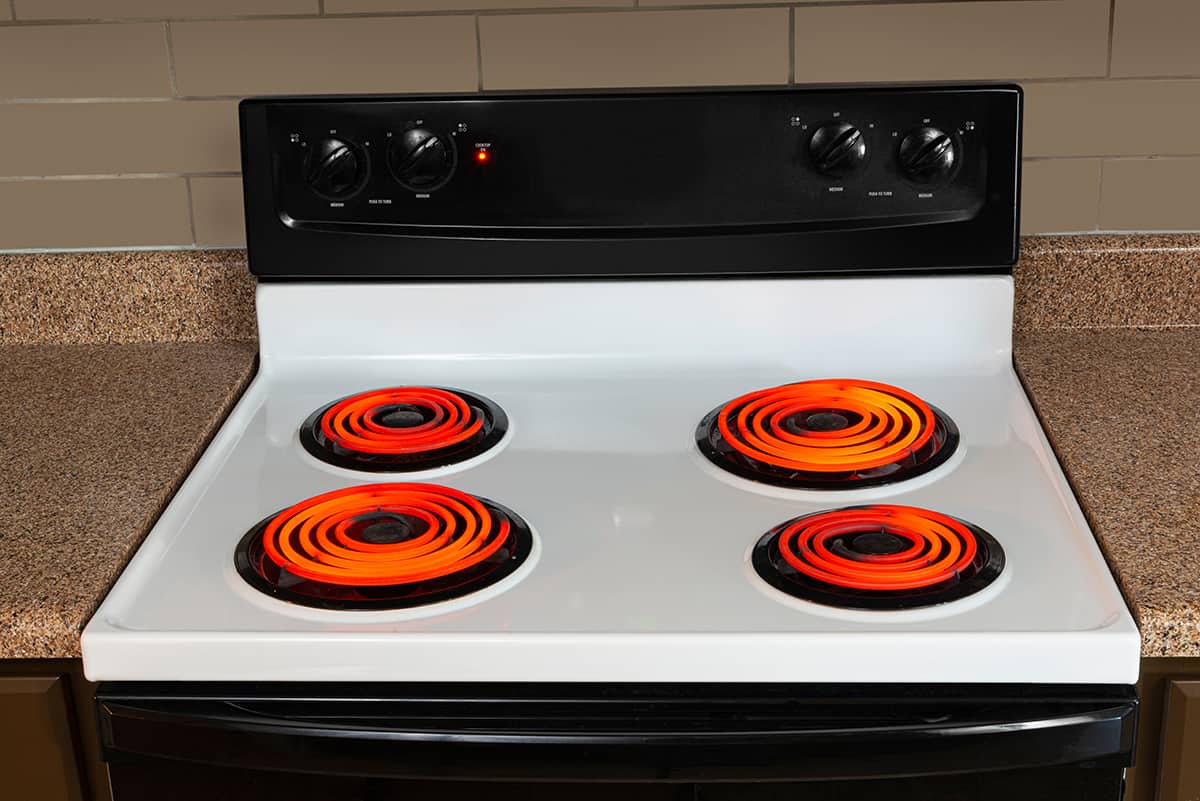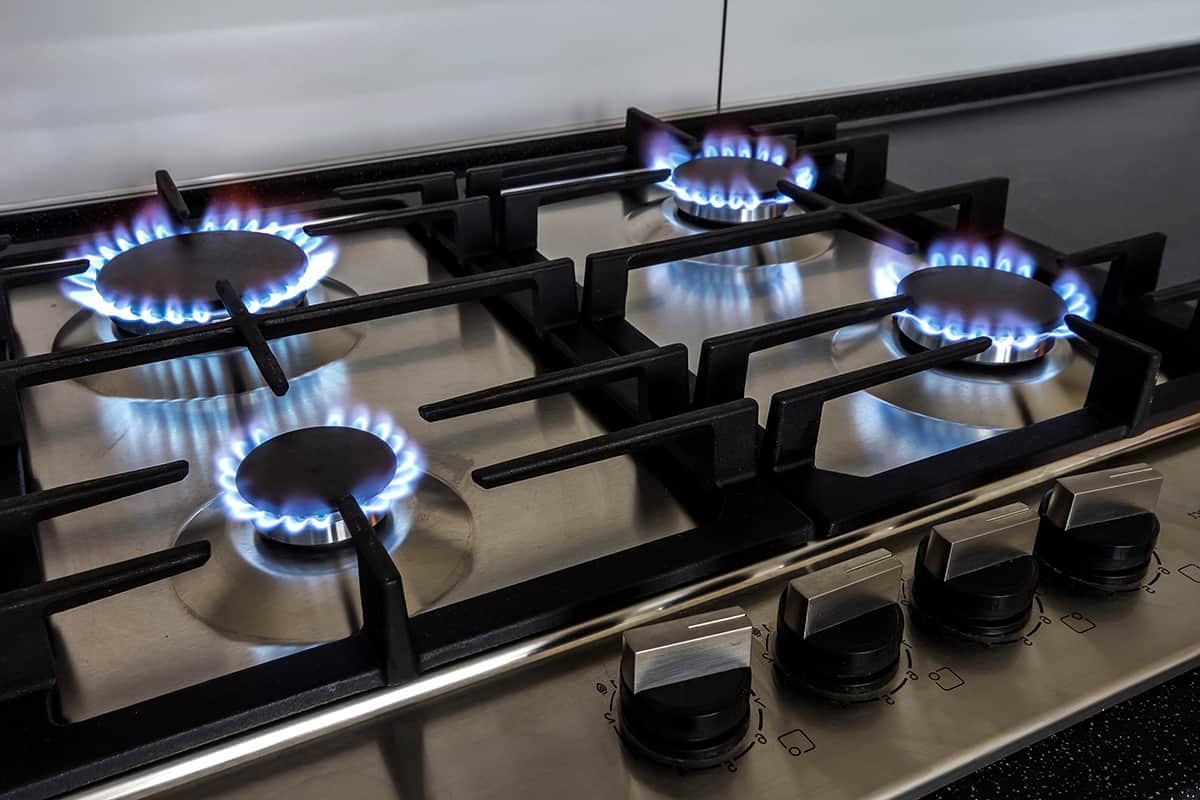It goes without saying that stovetops can get extremely hot. After all, that’s how we cook our food on skillets, pots, and pans. But have you ever wondered how hot a stovetop gets?
The open flames on a gas stovetop can reach temperatures exceeding 3,500°F, whereas electric and induction stoves typically reach around 1,600°F and 660°F, respectively.
In this guide, I’ll speak in more detail regarding the various types of stovetops, what temperatures they reach, and how to estimate their temperature settings.
Gas vs. Electric vs. Induction Stovetops
Most kitchens are fitted with stoves, and most household stoves run on gas or electricity—the latter of which can be further split into electric and induction stoves. Of course, there are wooden stoves, but those are typically reserved for outdoor or camping excursions. As such, I’ll disregard them for the time being.
Below, I’ll describe the various stovetop types, as well as describe their pros and cons.
Gas stovetops

Gas stoves are the only common residential stove type that produces a live flame to heat up pans and cook food. To use a gas stovetop, you should have a steady, consistent stream of natural gas. So, your home should be connected to a gas line in order to turn on a gas stove.
Because of its open flame, users can have a greater idea of how high to turn their stoves on when cooking at different heat levels—e.g., low, medium, medium-high, and high. Also, you can adjust the size of the flame and cooking temperature immediately simply by turning the stove’s dials or knobs.
If you were to crank the dial on your gas stove, you should expect its flames to reach temperatures of 3,542°F, though on average, the temperature is usually around 2,000°F.
Pros
- Precise temperature control—Gas stovetops will usually come with notches or numbers on the dial to inform users of different temperature levels. However, what makes gas stovetops unique in this regard is that the size of the flame can be altered on the fly. So, you can start at medium-high heat to preheat your oil and increase the size of the flame to bring the oil back up to temperature dropping food in the pan.
- Quick heating—The temperature dials adjust how much gas flows through the burners. By turning the dial, you’ll see the size of the flame grow and shrink in real-time. There is hardly any waiting time when increasing the flame from low/simmer to high, although it will take time for the flame to heat up the cooking vessel.
- Large stovetop options—If you’re looking for a 4-burner model for your apartment or a 10-burner unit for your restaurant, you can find a gas stove that accommodates your cooking requirements. Best of all, the size of the flames from each burner is independent of each other, so you can have a burner for low heat and a separate one for medium-high or high.
- Usually, come with ovens—Just because you do the majority of your cooking on the burners doesn’t mean you should limit your cooking experience. Many gas stove models come with built-in ovens, allowing you to sear steaks up above and finish them in the oven without having to swap between appliances.
- Chars foods—Granted, all types of stoves can be used for charring food, but gas ranges do it best. Because the flames can reach temperatures of over 2,000°F, it doesn’t take any time at all to sear or grill meats and vegetables.
Cons
- Difficult to clean—Unlike induction stoves, gas stoves come with all sorts of detachable parts, each of which requires maintenance. You will have to remove the grates to scrub them, as well as wipe off the drip pans when your food boils over.
- Open flame can heat up your kitchen—Because gas stoves cook food over an open flame, the heat of the flame will waft into all sections of your kitchen. The longer you run the stove, the hotter your kitchen will become without proper ventilation.
- Requires a gas line—Gas stoves require gas. If your home, apartment, or dorm don’t supply you with a gas line, your stovetop options are limited to only electric models.
Electric stovetops

Now, if you live in an apartment or dormitory that doesn’t offer a live gas line to fuel a gas range, you don’t have to worry. There are gas-less alternatives for scrambling eggs and searing steaks. The first one I want to talk about is simply known as electric stovetops.
An electric stove doesn’t use grates to keep your pots in place. Instead, it comes with heating elements, also known as coils. When you turn the dial on an electric stove, the coils will gradually become redder with time, depending on how high far you’ve turned the dial. Redder coils generally mean high cooking temperatures.
Depending on the model and the thickness of the coils, an electric stovetop can reach temperatures of between 932 and 1,652°F.
Pros
- Budget-friendly—Electric stovetops are generally considered to be the budget-friendly stovetop option. However, this isn’t due to its upfront cost but rather how little energy it uses to operate. Of course, you will have to pay more for electricity the longer, and more frequently you use an electric (as well as an induction) stovetop.
- Easy to clean—The heating coils of an electric range are considerably easier to clean as opposed to the cast-iron grates of a gas stove. However, it can be just as annoying to clean the coils since you will have to do so just as frequently as you would gas stove grates.
Cons
- Slow heating—It takes time for the heating coils to come up to temperature. And it will take more time for the heat to transfer to your skillet. And it can take just as long for the coils to come down to a lower temperature, so you run the risk of burning your food.
Induction stovetops
Another plug-and-play type of stove that requires electricity to operate is called the induction stove. In appearance, it looks somewhat similar to a glass-top electric stove. However, instead of using heating coils, it uses the power of magnetic fields that almost immediately raise the temperature of the cooking pot or pan.
So, how hot do induction stovetops get? In reality, you can touch the top of an active induction stove and not feel any heat at all, let alone get burned. The magnetic fields react with magnetic materials—e.g., stainless steel, cast iron—and not human flesh.
That said, if you place a stainless-steel skillet on an induction stovetop, make sure to keep your limbs away from the metal portion of the pan. Induction stovetops can heat the surface of magnetic materials to up 665.5°F and higher.
Pros
- Instant temperature control—An induction stove takes little to no time at all to adjust the cooking temperature. So, if your pot of water is at risk of boiling over, you can immediately drop the temperature without lifting the pot from the stovetop.
- Easy to clean—Induction stoves usually come with a ceramic plate on which you place your magnetic cooking pots and pans. Removing food debris and spills from the ceramic plate is as simple as wiping them away with a microfiber cloth.
Cons
- Only suitable with certain types of pans—You need specific types of pans to cook with an induction stove. If a magnet sticks to the side of your pan, you’ll know it’ll work on an induction stove.
- Boiling over can be dangerous—Although you have full control over the cooking temperature, if a pot of water boils over, it can be dangerous to both the user and the stove. Luckily, induction stoves are sealed. However, the seal can become damaged over time.






